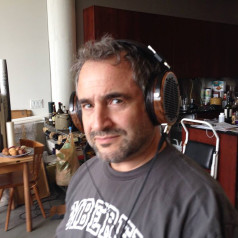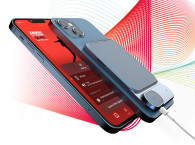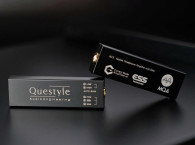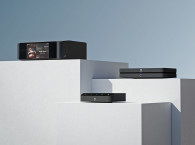
Unlike my child, my phone is not grafted to my hand. Also unlike children, I enjoy and expect a higher fidelity playback experience within my sphere of influence. For all of us, a smart phone is a staple though better sounding examples are bit of a rarity. There are “audiophile” phones, but they are as scarce and "spendy" as a mint original of the Shaggs’ Philosophy of the World. The mobile audiophile has three choices; make do with the mediocre sound quality of the phone’s audio subsystem, throw down for a dedicated DAP (a Digital Audio Player appliance such as an Astell&Kern or Pono) or purchase a usually more capable outboard solution. The folks at THX, better known for their certification service and classic Deep Note audio logo, have entered the outboard mobile DAC fray with THX Onyx, their super slim and stylish take on a modern, MQA-capable, bus-powered portable DAC with integrated headphone amplifier (HPA).
The $199 THX Onyx takes the form of a short, machined and black anodized aluminum wand the thickness of a pencil and less than twice that width. One side is blank, the other sports a gleaming THX logo that sits slightly proud of the case along side three tiny idiot lights for user feedback. Unlike the zaftig, two piece DAC+HPA solutions that fussy audiophiles employ, "Onyx" as I’ll refer to it going forward, is the Little Black Dress of mobile musical consumption. Within its miniature interior lies an ESS Technologies Sabre ES9281A PRO DAC with the Hyperstream II QUAD DAC architecture being fed from an integrated USB receiver with integral jitter reduction. In place of the in–built, Sabre Class-G headphone amp that ESS provides, THX enlists their Achromatic Audio Amplifier (THX AAA) technology.

Onyx is the first mobile device to feature the THXAAA-78 chip, and the THXAAA family extends from lower power versions for cost–conscious mobile to higher power versions for desktop designs. When asked about implementation specifics for Onyx, I was told that it is "...semi–discrete using high performance non-custom chips and discrete components." The THXAAA-78 used sits in the middle of a family that ranges from ultra-portable versions to higher power portable AAA configurations including the AAA-28, 38 and 78, and top out with desktop configs that include the AAA-688, 788, 789 and 888. As to power supplied, there is "...just one bias voltage rail; ±4.75V is used in the AAA-78. It is not using a Class G/H supply rail like AAA-888 does. There was no space for such a configuration within THX Onyx."
Onyx is a feed–forward design, with a Class AB driver stage and a Class AB output stage with minimal bias current (near-Class B). Unlike some other AAA topologies, THX told me there is "...no usage of Class G/H moving rails in THX Onyx, although we use those elsewhere," as in their AAA-888 chip mentioned above. Since Onyx is bus–powered, in this application the key benefit of AAA is "minimal bias current and highly efficient power management to optimize and extend device battery life" as stated by THX. Onyx offers a very low 0.2Ω output impedance while developing a respectable 180mW of power (per channel @ <0.3% THD). AAA technology offers very low quiescent current while also reducing harmonic, intermodulation, and crossover distortion plus noise to crazy low levels.
To quote the folks at Benchmark Media Systems, who pioneered the use of the THX tech, "THX-AAA Technology includes an ultra-clean low-power error-correction amplifier that runs in parallel with (a) high–power main amplifier. The correction amplifier actively drives the output while the main output devices transition between push and pull states." The result is a significant reduction in crossover distortion when compared to the typical Class AB topology.

More bulky and expensive two box DAC+HPA solutions usually provide higher output power and are often self–powered, reducing battery drain when paired with a phone. That said, Onyx does support a headset so, if you are using your phone, you can take calls using Onyx without missing a beat. I didn’t have any 300 or 600Ω headphones to try Onyx with, but I do own Audeze’s circumaural LCD-3 and El-8 planar magnetics, and the little critter provided more than sufficient playback volumes. With an assortment of efficient in-ear cans, from Westone's W60 to single balanced armature Klipsch X11i and Flare Audio R2PROs, ear splitting levels with a silent background were always on tap.
My trusty old iPhone SE has a Lightning connector, and Onyx comes with a USB-C at the end of its captive cable. I had no way of converting to USB-C, but a tiny, high style C female-to-A male adapter is included so all of my testing was done with my also trusty and ancient MacBook Pro. Onyx is an MQA renderer, so I began my auditory explorations of its playback prowess with TIDAL's native player in Exclusive mode. The TIDAL client gets the job done but lacks the refinement of 3rd party players Amarra and Audirvana so I switched over to those, my two preferred apps for this task.
With a variety of classical, jazz, pop and folk/bluegrass, I compared Onyx to my current MQA reference, the mega more expensive Mytek Brooklyn desktop DAC. The Onyx subjectively presented a drier, leaner delivery than the already lean Brooklyn. On somewhat fairer footing, I then swapped out the Brooklyn for my beefy and weighty Sony PHA-3, a self–powered portable DAC+HPA. The Onyx subjectively exhibited a slight mid forward voice with a bit more presence, a bite at what seemed to be around 9k, while it’s bottom lacked the control and authority of the PHA-3. The well over $700 Sony offered a dense, silky touch with a more expansive soundstage that the cooler, leaner Onyx lacked, which is no surprise given the huge difference in price. Overall, the Onyx comported itself extremely well, considering its very affordable cost and diminutive form factor.

Whether you're gettin' your macho on with Call Of Duty: Black Ops Cold War, chillin' to your fave lossless streaming tunes, or revisiting The Mando as he cons Herzog's Client and krew, the THX Onyx accesses a whole new world of fidelity. Pick your poison; Windows, macOS, android or iOS, and grab either headphone or headset. The THX Onyx goes wherever you do, from a Zoom meeting in the park to a long commute by air, train or bus.
It would also admirably serve in a second system in your office or vacation getaway. At $199, the price/performance ratio can’t be beat. You’ll pay more elsewhere for a volume control and choice of filter settings but, if those are not of great concern to you, the THX Onyx should be on your short list for long sessions of immersive audio enjoyment.
www.thx.com
Enjoying Full Hi-Res Music
MQA is a proprietary codec, usually lossless but at times slightly lossy. It employs two stages of compression, a lossless 2-to-1 phase, and a sometimes lossy additional 2 or 4-to-1 step. These "foldings" or compression steps can be decompressed in a symbiosis between software and hardware. The first unfolding of an MQA Core, results in sample rates of 96kHz or lower. TIDAL’s client decodes or "unfolds" the Core, as does Amarra and Audirvana, regardless of DAC used. Externally, a Core file or stream appears to be 44.1 or 48kHz PCM. As with HDCD or MLP, additional data is hidden in the Core and, when fully "rendered" or decoded, can reconstruct a stream up to 384kHz. In my case, rendering occurred in hardware in the ESS chip, and since the ES9281A can operate at up to 16x or 768 kHz, I was able to listen to fully decoded streams in all my favorite ways.








